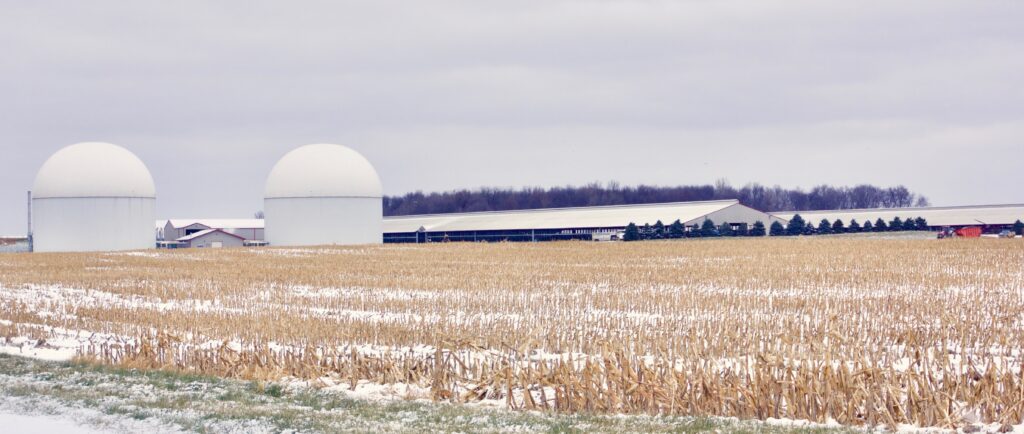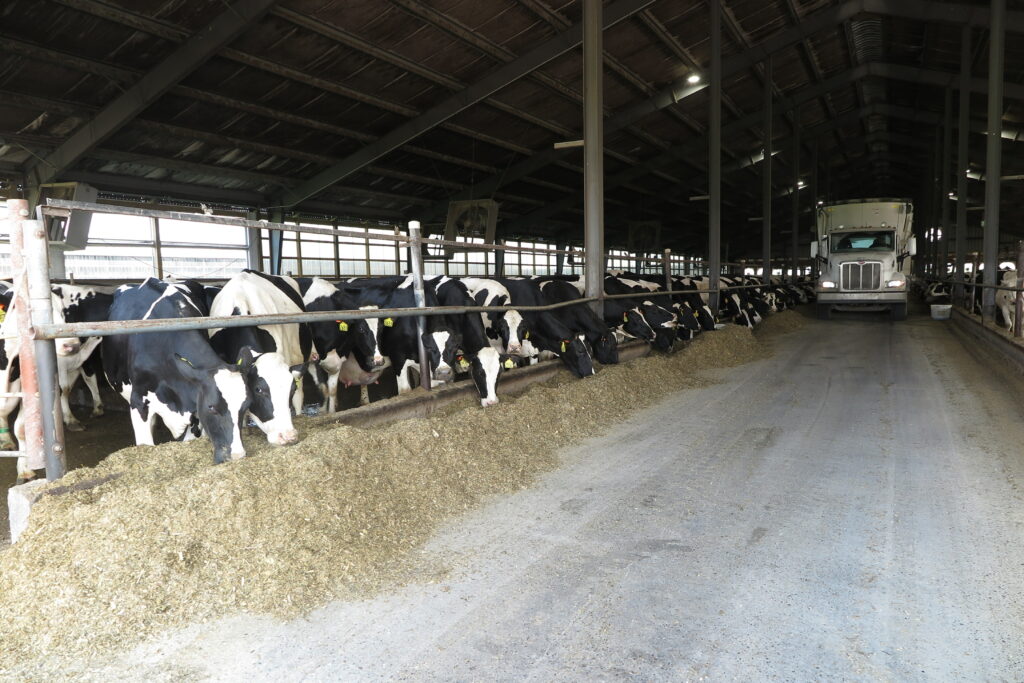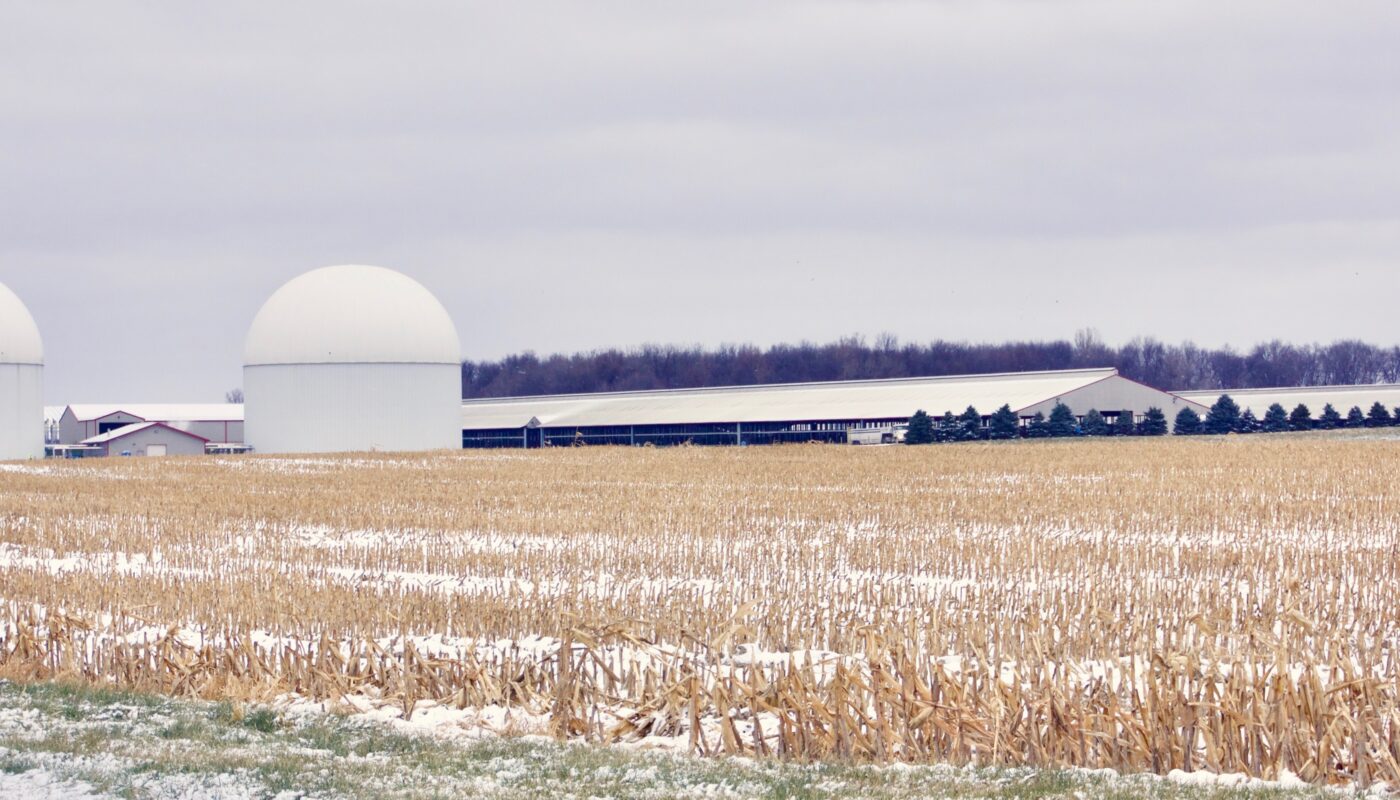
Michigan’s largest livestock feeding operations. (Photo/Keith Schneider)
AMES, IOWA – Because crop farmers can apply as much commercial fertilizer as they like to farmland, and livestock farmers spread over one billion tons of raw livestock feces and urine, the U.S. Environmental Protection Agency has identified nutrient discharges from U.S. agriculture as “the single greatest challenge to our nation’s water quality.”
The E.P.A.’s effort in stemming the pollution, though, has been listless for decades. And the farm sector categorically rejects accountability and responsibility for its wastes. With those axioms in mind, and with the unbridled enthusiasm that only Corn Belt agriculturists can muster, farmers and financiers gathered at a conference here in November to promote an alternative use for manure and a potential blockbuster breakthrough for animal agriculture.
How? By attaching big methane biodigesters to thousands of large livestock and poultry feeding operations. The conference’s host, Iowa State University, and it primary sponsors, the E.P.A. and oil giant Chevron, assured attendees that biodigesters would yield a harvest of potentially useful public interest results. Renewable energy to replaces fossil fuels and slows climate change. Waste disposal practices that could reduce water pollution. Billions of dollars in new farm income.
“It can provide a substantial portion of global energy needs,” said Rudi Roeslein, whose Roeslein Alternative Energy built and operates farm-based methane systems around the country that produce enough fuel to displace 6 million gallons of diesel fuel and 80,000 cars. “If we do this on a large scale in the U.S. we could generate $63.6 billion worth of revenue for farmers around the country.”
But critics outside Iowa argue that the emergence in Ames of an alliance of Big Ag, Big Oil, and Big Government to generate energy from livestock waste is ripe with peril. They identify a dark hole in the argument for digesters. Air pollutants and waste discharged from farms, and from farm-based biodigesters, receive scant federal and state oversight. Agriculture already is the nation’s largest source of water pollution, and one of the principal causes of air pollution, too. Lightly regulated manure digesters could make both worse.
“We’re facing a very dystopian future where we’ve turned animals in these confinement operations into our gas stations and power plants,” said Tyler Lobdell, a staff attorney and biodigester expert with Food and Water Watch, a national environmental group. “That should alarm anyone who cares about public health or environmental protection because factory farms by their nature are designed to be extractive and polluting facilities. That’s just how they operate.”

are the focus of biodigester construction. (Photo/Keith Schneider)
Lobdell and Rebecca Wolf, his colleague at Food and Water Watch, assert that billions of dollars being poured by government and the oil sector into producing methane on farms, where thousands of animals are confined, will prompt manure biodigesters to grow larger and more numerous. Economies of scale, they say, could make methane the primary profit center of enormous animal feeding operations, which are now the standard for the nation’s meat and milk production.
In other words, biodigesters could elevate manure — not meat or milk — as a principal product, and energy as a primary source of revenue for livestock and poultry feeding operations. “The reality is that you have all this manure from a factory farm system that has been a systematic part of federal policy for decades,” said Wolf, the group’s senior food policy analyst “Now we come along with a scheme to make money with it that is a Band-Aid on a completely out-of-control pollution problem.”
Old Technology Put to New Use
Farmers have known for centuries that flammable gases from piles of manure could be collected and burned. Contemporary gas production on livestock farms relies on sealing dairy, cattle, and hog manure lagoons in plastic or building big mixing tanks. Both are essentially giant crockpots that slowly cook wastes in an oxygen-deprived (anaerobic) bacterial broth. The methane released is trapped and processed for fuel.
To some extent the promise and the peril of digesting manure to produce methane has been a simmering conversation in U.S. animal agriculture since 1993, when the Clinton administration released a climate action plan and established the AgStar program at the E.P.A. to promote its use. At the time, only a handful of farm-based biodigesters were in operation because manure had not yet become a national mess.
Around the country, 1.46 million farms fed 163 million dairy cows, cattle, and hogs, and 5.4 billion chickens, according to the 1992 U.S. Agriculture Census. But a sizable number of dairy cows and cattle were still being raised on pasture where they pooped on the ground. Hogs were fed in smaller feedlots.
Over the next decade, though, federal and state incentives coaxed farmers to confine animals in much larger feedlots that produced more manure stored in massive lagoons. Many of them leaked. Recognizing the mounting tide of manure, Congress encouraged farmers to consider the waste as a source of energy and approved a provision in the 2002 Farm Bill that made livestock and poultry farms eligible for $450,000 grants to build biodigesters. Over the next eight years 160 biodigesters were installed on U.S. livestock operations, according to the E.P.A., most of them for big dairies that used the gas to power electrical generators for farm operations.
Never, though, has the interest in biodigesters been as keen as now. The E.P.A. counted 343 farm-based digesters at the start of 2023. The American Biogas Council, the industry’s Washington, DC-based trade group, estimates 8,600 more could be developed over the next decade or two.
The biodigester bonanza is stirred by two seminal trends. First is that the livestock and poultry sector has grown much larger, more concentrated, and has moved indoors. Twice as many cows, cattle, and hogs are raised, along with 3.5 billion more chickens on 460,000 fewer feeding operations as there were in 1992, according to the U.S. Agriculture Census. They annually produce 1.4 billion tons of liquid and solid manure.
Numerous federal and state studies have found that manure is responsible for much of the nitrate and phosphorus that contaminate Lake Erie, the Chesapeake Bay, most of the surface water in Iowa, much of the groundwater in Minnesota and Nebraska, and add to a mammoth toxic dead zone at the mouth of the Mississippi River in Louisiana.
California is Center of Industry
The second trend is the state and federal incentives that started in 2011 when California established a program to replace fossil transportation fuels with cleaner renewable low carbon fuels, and deemed methane production from farm biodigesters eligible for public support.

ripe for methane production. This one is in northeast Iowa. (Photo/Keith Schneider)
The intent was to limit emissions of methane, a greenhouse gas 80 times more potent than carbon dioxide over a 20-year time period after it’s released. Agriculture was seen as a prime culprit because livestock is responsible for more methane in the atmosphere than any other industrial sector, including oil and gas drilling and refining, according to the E.P.A.
But critics of the California program noted giant flaw in the justification for publicly funded farm-based digesters.
According to federal data, the bulk of emissions in agriculture – 70 percent – comes from so-called “enteric processes,” the methane-producing digestion in ruminant animals. That won’t change much, if at all, because the science for curbing belching and farting dairy cows and cattle is in its infancy.
Only 30 percent of methane generated in agriculture is from manure.
California, nevertheless, sought to convert those emissions and process it into fuel for transportation or electricity. Between 2015 and the start of 2023, the California dairy sector received $214 million in state and $433 million more in matching funds to build biodigesters on 131 farms, according to state data.
Second, California developed a carbon credit trading system that makes methane production in biodigesters a lucrative source of revenue for farmers and digester developers.
A million BTUs (MMBTu) of methane digested from manure is currently worth $3.00 in the value of the gas, and about $60 in various low carbon tax credits. A typical manure lagoon filled with millions of gallons of liquid manure from 2,500 cows produces about 45,000 (MMBTus) of methane worth $135,000 at current prices, according to research by Aaron Smith, an agricultural and resource economist at the University of California at Davis, and $2.75 million in carbon credits. Those credits can also be used by oil refineries to meet the goal California has set to reduce transportation emission 20 percent below 2010 levels by 2030.
Biodigestion under the California system also is a deal for farmers. The total annual value of carbon credits per cow at a 2,500 head dairy: about $1,100, according to Smith. In addition, each cow produces 24,000 pounds of milk annually, valued at more than $4,000.
Presented with such encouraging financial data, and with a desire to keep its vast gas processing and pipeline infrastructure operating, Chevron jumped into the market. In 2020 it partnered with California Bioenergy, a renewable fuel producer, to install biodigesters on eight clusters of dairy farms in the Central Valley to turn manure from 80,000 cows into methane for transportation fuel.
The California credits are available to any company that produces methane from biodigesters and can connect to a pipeline that serves the California market. That prompted Chevron to reach agreement with Brightmark Energy, a California-based company that has developed 23 “circularity centers” to generate methane from dairy manure, most of them in the Midwest. The five centers in Michigan, for example, include 11 digesters operating on eight farms totaling over 22,000 cows.
In 2023, Chevron announced it would spend $10 billion over five years for “lower carbon projects,” including methane from farm-based biodigesters. Neither Chevron, Brightmark, nor Cal Bioenergy agreed to be interviewed. But in public announcements Andy Walz, President of Chevron’s Americas Products, said the company is “committed to improving how affordable, reliable, ever-cleaner energy is developed and delivered.”
Other big oil companies also are engaged. BP announced a 15-year agreement with Maryland-based CleanBay Renewables in 2021 to purchase methane for transportation fuel from Chesapeake Bay poultry wastes. The same year, Enbridge, based in Canada and one of the world’s largest oil and gas pipeline companies, announced a $100 million partnership with Vanguard Renewables, a U.S. developer of renewable gas, to build and operate up to 8 digesters in the Northeast and Midwest.
And last year Shell paid almost $2 billion to acquire Nature Energy Biogas, Europe’s largest producer of methane from agricultural wastes. Shell began developing facilities at dairy farms in Kansas, Idaho, and Wisconsin.
“The oil industry’s entrance is really worrisome,” said Andrew deCoriolis, executive director of Farm Forward, a California-based group that opposes factory farming. “The size of the operations will follow the size of the new players. There’s a lot of new money coming in to finance the growth and consolidation of these operations, to scale them and make them more intensified. They’re going to get bigger.”
How much bigger? Smithfield, the nation’s largest hog producer, operates a feeding operation in Milford, Utah that raises 1 million pigs a year. North Dumas Farms in the Texas Panhandle feeds 72,500 cows. Riverview, a Minnesota-based milk producer, has an operation in Cochise County, Arizona that feeds 120,000 calves and heifers.
That’s a lot of manure and a lot of methane attracting a lot of money. More is on the way.
Biden Acts
Three years ago President Biden signed the global pledge to reduce airborne methane emissions 30 percent by 2030. In 2021 the White House produced a domestic methane reduction plan that focused on agricultural emissions. In 2022 President Biden signed the Inflation Reduction Act, which included $280 billion in clean energy tax breaks and other incentives to support clean fuels, reduce emissions from the transportation sector, and support clean rural electrification.
Here’s a sampling that includes funding for biodigesters. Rural electric cooperatives are eligible for $9.7 billion to build out renewable energy infrastructure and $1.7 billion more to boost small-scale renewable energy projects in rural areas. There’s $18 billion for “climate-smart” lower-carbon feedstocks. The law increases investment tax credits up to 50 percent or more for qualified projects rather than the historic 30 percent. And it established a $27 billion Greenhouse Gas Reduction Fund for early-stage renewable energy projects.
Iowa State, the Ames conference sponsor, is especially interested. The 165-year old university is to agriculture what Los Alamos is to nuclear engineering. Its plant breeders and animal researchers have lab-benched and field-tested virtually every significant development in crop and livestock science that led to American industrial agriculture.
Iowa State led the way for Iowa to become a colossus of manure-generating agriculture. The state’s livestock and poultry population numbers 24 million hogs, 3.6 million head of cattle, 240,000 cows, 54 miIlion chickens, and nearly 17 million turkeys. Methane from manure, as a result, has become one of the university’s prime imperatives.
In presentation after presentation, faculty members and finance specialists laid out the labyrinth of financing mechanisms for developing manure digesters to produce what they called “clean renewable fuel.” Jake Dunton, who manages the E.P.A.’s AgStar program, was similarly enthusiastic. “I would hazard a guess,” he said, “that with the new incentives that are coming into focus right now, as well as all the attention that anaerobic digestors are getting, this is going to take a sharp increase.”
Other speakers assured participants that biodigesters have other virtues. They can help eliminate the noxious odors that plague hog and dairy regions across Corn Belt states. And digester wastes, called digestate, could reduce nutrient runoff that fouls surface and groundwater. How? Several speakers noted that the Inflation Reduction Act provided more money, for instance, for farmers to grow winter cover crops, fertilized with digestate, that would limit nitrate and phosphorus runoff.
No Controls
All of the assurances about the environmental value of digesters, though, crumble because of two unassailable facts.
First, even the U.S. Department of Agriculture is concerned about digestate, which is produced in nearly the same volume of liquids and solids introduced into the system. Exposing manure to heat and bacteria in an oxygen-depleted digester changes the chemistry of phosphorus and nitrates and makes them more hazardous to water. “Land application of digester effluent, compared with fresh manure, may have a higher risk for both ground and surface water quality problems,” according to the Natural Resources Conservation Service Federal Code for operating biodigesters. “Compounds such as nitrogen, phosphorus, and other elements become more soluble due to anaerobic digestion and therefore have higher potential to move with water.”
Here’s the essence of the second problem: Air emissions and waste discharges from farm-based biodigesters are largely unregulated.
In Michigan, as in other states, biodigesters operated by food processors or waste water treatment plants are tightly overseen by air and water pollution control laws. Operators must limit air emissions of hydrogen sulfide, nitrous oxide, and other gases from biodigesters at their facilities. They are required to direct the liquid portion of digestate back into the plant for treatment. Regulations are equally strict for spreading “biosolids” from biodigeters on land.
But the air emissions and digestate discharges from the very same equipment and processes installed on agricultural biodigesters are not required to operate with the same level of control for hydrogen sulfide, nitrous oxide, and other air pollutants. And digestate solids are regarded the same as manure. Farmers are free to treat farmland as waste disposal sites in Michigan and other states so long as the phosphorus, nitrates, and E.coli bacteria from manure that runs into streams and groundwater aren’t causing incidents that kill fish or make people sick.
Allowing animal agriculture to evade oversight means the nation misses the opportunity to curtail one of the country’s largest sources of water pollution from manure. If farm-based digesters are regulated, like they are at municipal waste water treatment plants, air emissions would be closely controlled. Digestate would be required to be treated and disposed of with much greater care for water quality.
Ames conference speakers and attendees did not focus on that. Much more significant was tapping into the billions of dollars in public subsidies now available to push agriculture to the center of U.S. energy production.
“All these incentives to produce methane from manure amounts to a pay-to-pollute scheme,” said Rebecca Wolf of Food and Water Watch. “Developers are making money off pollution. Once you start doing that, there is no incentive to roll it back.”
— Keith Schneider
This article was published by The New Lede, Circle of Blue, and several more non-profit public interest news desks and is part of my Toxic Terrain project on the national scandal of massive farm nutrient contamination of the nation’s waters. The Alicia Patterson Foundation and the Fund For Investigative Journalism awarded fellowships to report the project. Carey Gillam, editor of The New Lede, edited this piece.



